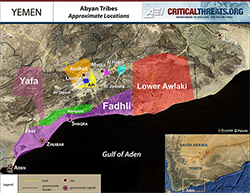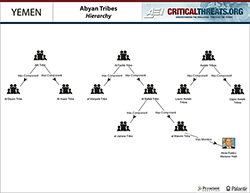{{currentView.title}}
July 25, 2012
Abyani Tribes and al Qaeda in the Arabian Peninsula in Yemen
Ansar al Sharia, the insurgent wing of al Qaeda in the Arabian Peninsula (AQAP), surrendered the city of Azzan to the Yemeni military on June 23, 2012. Its fall was the last blow in the Yemen army’s campaign to retake the cities of Ansar al Sharia’s “emirate” in south Yemen. These cities had fallen over the course of the month to militias composed of local tribesmen partnered with the military. The prospect of relying entirely on tribes to police south Yemen for AQAP and Ansar al Sharia is tempting given this success. Yemen’s tribes are well armed and numerous, and their support has been courted by many governing powers over the centuries.
In fact, working with and through the Yemeni tribes will be the key to any long-term solution to the Ansar al Sharia and AQAP problem. But it would be unwise to rely entirely on the tribes to keep AQAP out of south Yemen, where tribal culture has been damaged by government policy and there are signs of tribal fracturing and weaknesses. The progress that tribes have made against AQAP has also required the deployment of a significant portion of the Yemeni army. A sustainable “tribal solution” to AQAP and Ansar al Sharia is unlikely to be effective by itself for these reasons.
Tribes and Tribal Identity
Tribalism is not the only lens through which to examine Yemeni social networks. Tribes are composed of individuals, each with his or her own set of loyalties. Family, religion, geography, and a host of other factors can make claim on a Yemeni’s allegiance, and tribal membership is just one of those factors. Tribal allegiance is also not uniform: it varies according to region, social class, and personality. Moreover, tribalism in Yemen has been weakened over time by the forces of modernization, urbanization, and the Arab youth bulge. Decades of corruption under the recently ousted President Ali Abdullah Saleh also damaged the tribal system.[1] However, tribes remain important in Yemen and can provide a useful, structured way to work with the society, as long as one has a thorough understanding of their weaknesses and dynamics.
Tribalism is particularly fractured in the south. This part of the country was an independent Marxist state for a little over two decades. Its government, which came to power in 1968, discouraged tribal affiliations.[2] The state dissociated the tribes from their ancestral lands. Prominent tribal leaders went into exile. Saleh assumed power of the unified country in 1990 and proceeded to award the pick of jobs, land, and contracts in the former South Yemen to members of northern tribes and to his political allies, a fact that undermined tribal dynamics and rankles native southerners to this day.
It is difficult to work with a tribe as a unit. A sheikh, the leader of a tribe, is not an absolute ruler. Rather, his traditional duties are serving his people’s interests by arbitrating conflict within his community and with outside tribes.[3] He holds the position through the support of his constituents.[4] Any member of a tribe may be elected or removed by his peers in theory.[5] Saleh’s patronage system undermined this tradition. The former president propped up certain sheikhs by increasing their individual wealth and power beyond usual standards, meaning that a sheikh was no longer beholden to his tribesmen.[6] Saudi funding of tribal sheikhs had similar effects.[7] The elevated sheikhs live in relative opulence, often living in the capital rather than living their constituents. Many tribesmen became estranged from their leaders as a result.
The corruption of the tribal system is a potential boon to Ansar al Sharia and AQAP, whose numbers have swollen in the past three years.[8] Ansar al Sharia is enticing young tribesmen to join up with promises of salaries and weapons.[9] Meanwhile, the lower sheikhs, who were passed over for benefits from the government in Sana’a, the capital, are unable to provide, and are reported to be taking food and water from Ansar al Sharia in exchange for new recruits.[10] Ansar al Sharia and AQAP are also recruiting among tribes whose elders reject the group.[11] In these cases, the lack of tribal cohesion is playing into Ansar al Sharia’s hands.
It is problematic to rely on Yemeni tribes in the long term because Yemeni tribes are not ideologically consistent in their loyalties. Rather, they have always been marked by their adaptability. Tribes in Yemen have a history of being bought off. Many experts have pointed out that tribal allegiance is not won over by ideology, but by money, jobs, and land.[12] The Imam in the former North Yemen kept tribes compliant with stipends.[13] The British Protectorate in the south did the same with the tribes surrounding Aden and the eastern territories.[14] Saleh infamously paid off tribal leaders and distributed favors. Sheikhs have also accepted bribes from foreign actors in the region.[15] Tribal support is also opportunistic, and ended once the benefits dried up in many instances. Ansar al Sharia understands that it can win support by providing advantages to the tribes. It has attempted to use this tactic in Abyan and Shabwah by provision of (relative) security and vital goods and services.
Ansar al Sharia’s Campaign to Win Support in the South
Ansar al Sharia was able to exploit local grievances in strategically significant southern territory over the course of the Yemeni uprisings against former President Saleh’s government. Abyan lies within striking distance of the port city of Aden and provides access to main roads leading north to Sana’a. Ansar al Sharia has an advantage in the disrupted history of these southern areas, where many residents feel marginalized.[16] Its propaganda highlights improvements under its oversight that the Yemeni state did not provide. Ansar al Sharia distributed several news reports on living conditions under its year-long “Islamic emirate” through its media arm, Madad News Agency.[17] Common themes in these releases are the enhanced security and fair treatment of southerners; poor security and the nepotism favoring the northern tribes are frequent complaints of southerners.[18] Ansar al Sharia provided legal adjudication by sending so-called legal experts to advise governorate-level courts and by establishing shari’a courts. At least one tribe sought dispute settlement in these courts.[19] The militant group also canceled taxes in Jaar and Shaqra, two towns that fell under its control in Abyan, and was supplying food, water, and electricity, as documented by Madad reporting.[20] A foreign journalist visited the cities under Ansar al Sharia control and reported on these improvements, which included the installation of sewage pipes and the expansion of the electrical grid.[21]
The quantity of the goods provided may have been small in the end, but the significance of the services carries weight in the south, where poverty and poor infrastructure are decades-old problems. Limited resources and mismanagement due to corruption in Sana’a meant that many basic improvements did not reach the area. Even Sana’a does not enjoy constant electricity.[22] The Yemeni government was failing to provide many of the Abyanis’ basic needs – security, electricity, food – and Ansar al Sharia was eager to show that it could fill the gap. The efforts to reach out to the tribes were nascent, but intelligent and persistent.[23]
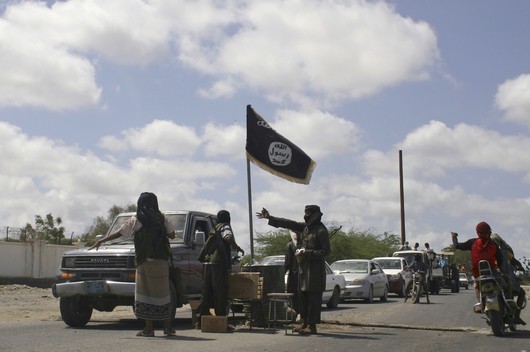 Members of Ansar al Sharia man a checkpoint in Jaar April 28, 2012 (Reuters)
Members of Ansar al Sharia man a checkpoint in Jaar April 28, 2012 (Reuters)Ansar al Sharia has an additional advantage: the government often bears the blame for not maintaining stability. The group can blame the national army for violence and civilian casualties. Under both Saleh and his successor, Abdu Rabbu Mansour Hadi, multiple brigades were deployed to reclaim Ansar al Sharia-controlled areas and frequent air raids targeted militants. The violence in Abyan had reached the point that in the nearby city of Aden alone there were 100,000 refugees.[24] An Ansar al Sharia leader asks a group of soldiers captured during a Yemeni offensive in Zinjibar in one Madad press release, “Did we come to your homes to capture you? Did we go to your camps to attack you, or are you the ones who came to the outskirts of Zinjibar to kill us?...Why did you fight us?”[25] He blames America and what he considers its puppet state in Sana’a for the violence in the south. Some of the tribes have agreed with this message; they blamed the Yemeni government, and the U.S., for the deteriorating security situation.[26]
Meanwhile, Ansar al Sharia has constructed its image to be one that is devoted to keeping the peace. It was careful to avoid harming civilians and infrastructure where possible in towns under its control. Its most violent actions were reserved for areas where it faced strong resistance. In one of the only places where Ansar al Sharia militants destroyed local infrastructure – an electrical station in Lawder – the tribes were already actively engaged in combat alongside the military.[27] A member of the Assal tribe of Abyan was killed in the abutting governorate of Aden in another case. The tribe blamed the attack on al Qaeda because prior to the attack, the Assal tribe had driven Ansar al Sharia out of the city of Mudia.[28] Even the Ansar al Sharia court system is careful about punishing locals: when the group executed three men accused of spying for the U.S. and Saudi Arabia in February 2011, it selected men from the north – specifically, from Taiz and Ma’rib, governorates separated from Abyan geographically and culturally.[29]
Ansar al Sharia is also careful to stress its ties to south Yemen when possible. The “emir” or “governor” of Ansar al Sharia’s territory in Abyan, a charismatic figure named Jalal Muhsin Saleh Bal’idi al Marqishi, known as Abu Hamza, is perhaps the most prominent figure in Ansar al Sharia press releases.[30] The Marqishi tribe is from Abyan. Abu Hamza has also emphasized his local roots by adopting the name “Zinjibari.”[31] Zinjibar is the capital of Abyan governorate. Abu Hamza has addressed the people of Abyan in Madad press releases, calling them his brothers.
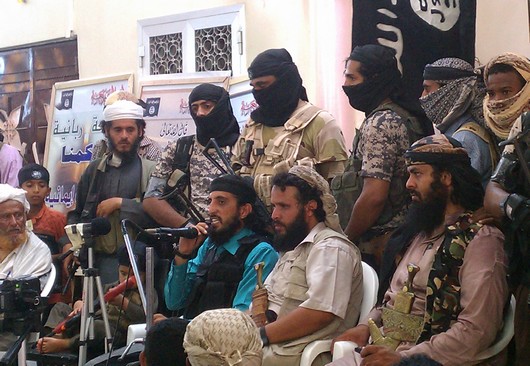 Abu Hamza addresses Yemeni soldiers upon their release in Jaar on April 29, 2012 (Getty)
Abu Hamza addresses Yemeni soldiers upon their release in Jaar on April 29, 2012 (Getty)Ansar al Sharia has also used its military campaigns to strengthen relations with the local tribes. The group captured 73 Yemeni soldiers during fighting in March 2012. Ansar al Sharia engaged with tribal negotiators to release the soldiers.[32] The insurgent group appeared to receive little or nothing from the deal – the exact terms of the agreement are not known – except a good public relations opportunity. Madad used the negotiations to show Ansar al Sharia’s good relations with the tribes. One press release shows a series of tribal leaders declaiming at an open gathering on behalf of the captives and praising the group for its decision to release the prisoners. Abu Hamza is present at the gathering and speaks as a representative of Ansar al Sharia. He grins and laughs while welcoming their speeches as the crowd behind him cheers.[33] The video also shows leaders from many prominent Abyani tribes speaking at the negotiations. This is not the first time the group had used captured soldiers to enhance its image. Other Ansar al Sharia videos show the group giving captured soldiers money to return to their homes, leaving them to go free as long as they pledge not to fight Ansar al Sharia in the future.[34] Soldiers fighting in the south are often from the southern governorates, and these displays of mercy are in all likelihood a calculated move to win support.[35] Ansar al Sharia is attempting to demonstrate its friendly relationship with local tribesmen through its media arm.
The Tribes of the South – Cooperation and Resistance
It is difficult to discuss tribal relationships in southern Yemen with Ansar al Sharia and AQAP without delving into the details. The following section provides some examples of tribal interactions with these groups in Abyan and Shabwah.
Fadhel Tribe
The Fadhel tribe is the largest tribal group in south Yemen.[36] The capital of the Fadhli territory is in Zinjibar, a city 35 miles northeast of Aden that is also the capital of Abyan governorate.[37] Ansar al Sharia seized control of Zinjibar in May 2011. The other two Abyani cities Ansar al Sharia occupied, Jaar and Shaqra, also fall in Fadhli territory. Ansar al Sharia had not encountered strong native resistance in these areas until April 2012.
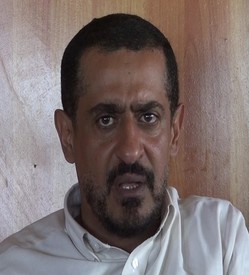 Tariq al Fadhli (Getty)
Tariq al Fadhli (Getty)Tariq al Fadhli, the paramount sheikh of the tribe, is an opportunist and has had a career marked by fluctuating alliances. He fled with Abu Hamza, the leader of Ansar al Sharia in Abyan, into the mountains around Shaqra after Ansar al Sharia’s defeat there this June.[38] He has a long history with Ansar al Sharia and the broader al Qaeda organization. He fought with Osama bin Laden against the Soviets in Afghanistan and returned to Yemen to become a leader in the Islamic Jihad in Yemen (IJY), an organization thought responsible for a string of hotel bombings and assassination attempts in southern Yemen, including the bombing of two Aden hotels in 1992.[39] Tariq reportedly oversaw the creation of AQAP training camps in Abyan in the past decade.[40] He has participated in mediation councils negotiating ceasefires and the release of Ansar al Sharia captives in the past six months.[41] He appeared at the ceremony of the release of the 73 prisoners in Abyan with Ansar al Sharia leader Abu Hamza and AQAP military commander Qasim al Raymi on April 29 of this year.[42] But his loyalties have fallen elsewhere over the years. He disbanded the IJY in exchange for a high position in Saleh’s government after the 1994 Yemeni civil war.[43] He is brother-in-law to the defected General Ali Mohsen al Ahmar.[44] Fadhli broke away from the government in April 2009 and announced his support for the Southern Movement, a largely socialist group of the type the IJY attempted to crush in the early 1990s.[45] His blatant opportunism makes Tariq al Fadhli the best example of the problems of relying on the Yemeni tribes in the long term.
The Fadhli tribe also struggles with a lack of cohesion. It is not unified behind Tariq al Fadhli. Some of the Fadhli tribesmen and sheikhs have openly rejected Tariq’s leadership, accusing him of threatening the stability of the south by maintaining ties to AQAP.[46] He has been rejected by members of the Southern Movement for similar reasons.[47]
There is evidence that some of the lower sheikhs of the tribe have been at odds with AQAP. One Fadhli sheikh, Hussein Mashdal, who was involved in ceasefire negotiations, was killed in an ambush in north Abyan by militants in September 2010.[48] AQAP was blamed. Beyond that, Fadhli has tense relationships with the neighboring tribes.[49] Abu Hamza’s tribe, the Marqishi, once fell under Tariq al Fadhli, but it too shook off his leadership in 2009, claiming that he was exceeding his bounds and stealing its lands.[50]
Awalek Tribe
The Awalek confederation is a large group split into two main subdivisions – the Upper and Lower Awlakis. The former is primarily located in Shabwah governorate, the latter in Abyan. The confederation’s lands include areas where AQAP has sanctuaries. The lands also include Wadi Rafad, where airstrikes have targeted AQAP leadership. AQAP operative and cell leader Fahd al Quso, from an Awlaki sub-tribe, was killed by a strike in Wadi Rafad on May 6, 2012.[51]
The Awlaki tribe, like the Fadhli tribe, is not unified. The tribe is divided between pro- and anti-AQAP camps, according to reporting in 2010.[52] The internal dispute has manifested itself in contradictory actions. Awlaki tribal elders issued a statement threatening violence against those who aided the U.S. in killing Anwar al Awlaki and had promised retribution “if a hair on his head” was harmed in 2010.[53] Awlaki tribesmen worked with the government to root out militants from their lands that same year.[54]
The Awlakis are one of the more powerful tribes in the Abyan-Shabwah area, partially because they were favored by the British under the old protectorate.[55] But the decision by some of their leaders to welcome AQAP did not mirror the sentiments of the surrounding tribes.
Other Shabwah tribes have complained that AQAP is recruiting their young men, and have taken action to restrict AQAP’s movements.[56] Tribesmen in the area of Mayfah and the Ansar al Sharia-controlled city of Azzan have fought the group’s incursion into their lands. These tribes also established checkpoints along the roads to the east and west of Azzan, which lies along the ancient trade routes from Sana’a to Hadramawt. These ancient trade routes now constitute an important supply route for AQAP to their havens in the east.[57]
Jadana Tribe
The Jadanis, whose territory falls east of Mudia city in northern Abyan, handed over one of their members to the Ansar al Sharia courts in Jaar, traveling some 70 miles to do so in April of 2012.[58] The case was serious; it involved the murder of a Jadani by a fellow tribesman. The Jadana tribe has a tense relationship with the Yemeni military, which is probably why the tribe was unwilling to turn to the government for aid in settling the dispute.[59] This was the first time that a tribe in Abyan had turned over one of its own to the Ansar al Sharia courts. A tribesman interviewed by a local newspaper said that the Jadanis did so because of their respect for the courts’ adherence to shari’a and their hope that this outside mediation would preempt a violent backlash in the community. Such outside mediation to prevent a blood feud would be executed traditionally by separate tribes, or even government courts. That Ansar al Sharia presented a viable third recourse has worrisome implications. If Ansar al Sharia was successfully establishing itself as a workable alternative to governmental or tribal authority, it may take more than the current military campaign to ensure its defeat in Yemen.
Awadhal Tribe and Popular Resistance Committees
Some tribes, such as the Awadhal tribe, also known as the Audhalis, had been fighting Ansar al Sharia insurgents in their territory with greater success before this summer’s campaign. The Audhali tribe of the Lawder area formed militias that Yemenis call “Popular Committees” or “Popular Resistance Committees.”[60] These committees fended off frequent Ansar al Sharia attacks on Lawder and ran checkpoints along the main road to Sana’a.[61] President Hadi’s tribe, the Maremi, also from the area around Lawder, joined the fight along with the local Diyani tribe.[62] These tribes were all supported by the Yemeni army’s 111th Infantry Brigade.
Popular resistance committees are not something new, but the push by the Yemeni army to clear Abyan and Shabwah that began in April 2012 coincided with a proliferation of these committees in several southern areas, including Zinjibar, Lahij, Shabwah, Mudia, and Lawder.[63] Authorities in Sana’a recognized the value of the committees: Hadi met with Abyan tribal leaders in early May 2012 to ask for the formation of more of them.[64] As a member of an Abyani tribe himself, Hadi may have an advantage in persuading local tribal militias to take up arms against Ansar al Sharia. He may not have such success in other areas, but that remains to be seen.
Conclusion
Yemeni military victories in Abyan and Shabwah are an encouraging development in the fight against AQAP and its insurgent wing, Ansar al Sharia. Now the cities of Zinjibar, Jaar, Shaqra, and Azzan must be protected and held. It is tempting to rely on local tribal militias to hold the ground, but the situation is precarious enough to warrant more vigilance.
The lesson of the past year is that tribes are essential to an effective campaign against Ansar al Sharia, but they are not a silver bullet. Tribal resistance proved relatively efficacious in the cities of Lawder and Mudia, but these areas still suffered from frequent attacks, including the destruction of a power station. Tribal committees also helped in failed attempts to clear Zinjibar in August of 2011.[65] Tribal support is vital in preventing the group from reclaiming its foothold in Abyan and Shabwah. But it may not be enough on its own to hold off future attacks and deny AQAP the operating room required to launch transnational attacks. Extensive Yemeni army support and U.S. military advisers helped to accomplish the string of victories in June 2012.[66] But it is unlikely that the Yemeni military will have the resources to continue this intensive campaign, especially given the distractions of ongoing protests, mutinies in the military, and the al Houthi rebellion in the northwest.
Beyond this, the U.S. does not in all likelihood have sufficient expertise to orchestrate the necessary tribal support in the long run. Saudi Arabia, another possible ally in the endeavor to create a tribal alliance against AQAP and Ansar al Sharia, probably also lacks the expertise – and the bandwidth – to achieve such a goal. Saudi relationships in the south are weaker than their alliances in the north, partly because Saudi Arabia backed the northern government in the civil war against the south. Ansar al Sharia used a year of occupying southern territory to win over the support and sympathy of the sheikhs and their tribesmen there. The physical fight against the insurgent group is not over, either. Ansar al Sharia was driven from the cities, but the militants have not fled farther than the surrounding mountains by many reports.[67] Ansar al Sharia fighters may still be in Jaar.[68] The U.S. must examine the likely requirements for external support to the tribes, by, with and through the Yemeni military and state if possible, but by other means if necessary. Understanding of the tribes to the furthest possible extent is the first step.

